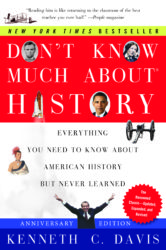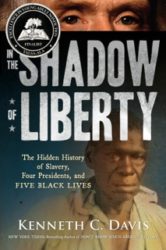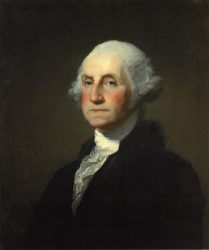
Portrait of George Washington by Gilbert Stuart (Source: Clark Institute Williamstown, Mass.)
[Originally posted July 2, 2020; revised February 22, 2024]
Today is actually George Washington’s Birthday. Maybe you thought you celebrated last Monday (not President’s Day). Seeing as the holiday falls in February –Black History Month– it is a good time to bring these two crucial pieces of history together.
There is no question that Washington’s accomplishments were central to the foundation of the Republic. His command during the Revolution. His role at the Constitutional Convention, where he presided. His two terms as president, in which he established many presidential precedents and then stepped aside. For these achievements, I described him as one of America’s greatest presidents. He was, as one biographer described him, the “Indispensable Man.”
But like many of the Founders, the “Father of Our Country” enslaved people. Inheriting ten people from his father at age eleven, Washington held more than three hundred men, women, and children in bondage at the time of his death in 1799. While one man was freed in Washington’s will, the others had to wait for Martha Washington to die. And roughly half of those people remained enslaved, parceled out among the Custis family, as part of the estate of Martha’s first husband.
In other words, George Washington was an enslaver from childhood to grave. And we have the receipts.
He once raffled off whole families in lots, including small children separated from parents. He later purchased four children at an estate sale, sending two dark-skinned boys to do fieldwork while two “mulatto” boys became house servants. Frank Lee became Mount Vernon’s butler and his brother Billy Lee served as Washington’s valet, his “loyal manservant,” for some thirty years.
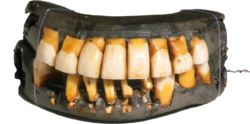
The last remaining set of Washington’s dentures (Courtesy: Mount Vernon Ladies Association)
Washington’s own journal records that he purchased teeth pulled from the mouths of enslaved people, presumably to be fitted into his dentures. In exchange for a grocery list of rum, molasses, fruits, and sweetmeats, he once shipped off a man named Tom, a repeat runaway, and at least two other men to the cane fields of the West Indies.
And then there is the heroic Washington’s actions at Yorktown. After his signal victory over the British in 1781, General Washington wasted no time in recovering Esther, Lucy, Sambo Andersen, and fourteen others who had escaped Mount Vernon when offered the chance. They were among thousands of enslaved people who had fled to the British in hopes of emancipation. While Washington won America’s liberty, they lost theirs.
Did this inconsistency trouble Washington? The contradiction between his devotion to freedom while enslaving people did seem to prick his conscience. In 1786, he confided to fellow Founder Robert Morris, “there is not a man living who wishes more sincerely than I do to see a plan adopted for the abolition of it [slavery].”
But he did precious little to make it happen, either while presiding over the convention that cemented slavery in the Constitution, or as first president. After Philadelphia became the nation’s capital in 1790, President Washington shuttled enslaved servants in and out of the city to evade a Pennsylvania law that called for the emancipation of enslaved males residing in the state for more than six months. In 1793, he signed the Fugitive Slave Act, making assistance to runaways a federal offense.
When Ona Judge, Martha Washington’s enslaved maid, learned she would be given away as a wedding gift, she escaped from the home of the president in 1796. He advertised a ten-dollar reward for her return and spent the next three years trying to track down and recover a woman who had risked all for freedom.
For more than two centuries, these contradictions were given little weight by Washington’s admirers. The little boy who couldn’t tell a lie was immortalized as “First in the hearts of his countrymen.” The enslavement of human beings, especially by one of America’s most admired presidents, remained the dirty secret long concealed by textbooks and popular culture.
But a stunning moment of correction has arrived. It begs the questions:
Will George Washington’s picture be removed from the currency?
Will protestors project the images of African-American heroes onto Washington’s stern visage carved on Mt. Rushmore, as Harriet Tubman’s face now adorns Robert E. Lee’s statue in Richmond?
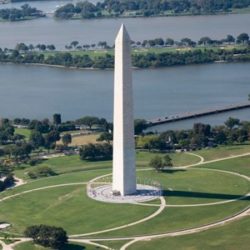
Washington Monument (Courtesy National Parks Service https://www.nps.gov/wamo/learn/historyculture/index.htm)
What about the Washington Monument?
We are now in a teachable moment. What we do is limited only by our creativity and the courage to be honest. We won’t take a chisel to the Washington Monument or spray paint it with graffiti. But we should teach students and all Americans that Washington was a flawed man who committed a crime against humanity while also building the nation. This was the “gross injustice and cruelty” that Frederick Douglass famously called out in his 1852 speech, “What to the Slave is the Fourth of July?”
Remaining silent on that injustice and cruelty is no longer an option. Because this is one of those “self-evident” truths. The United States was “conceived in liberty,” but born in shackles. We can no longer honor Washington’s indispensable achievements without recognizing his original sin.
What better occasion than Washington’s Birthday to do that.
